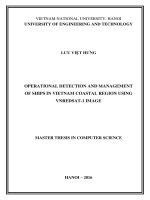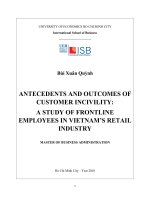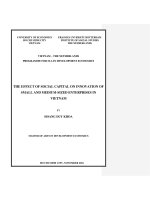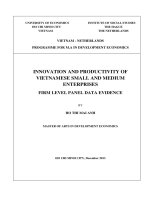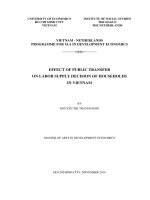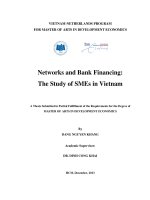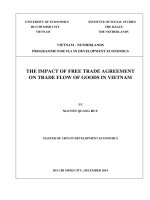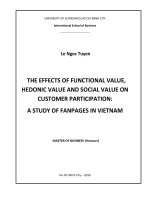- Trang chủ >>
- Cao đẳng - Đại học >>
- Luật
PROTECTION OF COPYRIGHT IN MUSICAL WORKS IN VIETNAM’S DIGITAL ENVIRONMENT
Bạn đang xem bản rút gọn của tài liệu. Xem và tải ngay bản đầy đủ của tài liệu tại đây (1.13 MB, 77 trang )
HO CHI MINH CITY UNIVERSITY OF LAW
THE MANAGING BOARD OF SPECIAL TRAINING PROGRAMS
BACHELOR’S THESIS
INTERNATIONAL LAW MAJOR
PROTECTION OF COPYRIGHT IN MUSICAL WORKS IN VIETNAM’S
DIGITAL ENVIRONMENT
STUDENT
STUDENT ID
CLASS
SUPERVISOR
Nguyen Kim Trang
0955020242
Advance Class 34
LL.M. Le Tran Thu Nga
HO CHI MINH CITY
2013
Statutory Declaration
I hereby affirm that this thesis, submitted in fulfillment of the requirements for
the bachelor thesis of the Faculty of International
Law, Hochiminh City
University of Law, is wholly my own work unless otherwise referenced or
acknowledged. All thoughts or quotations which were inferred from different
sources are clearly cited as such.
Hochiminh, 15th July 2013
Nguyen Kim Trang
1
INTRODUCTION
1. Necessity of research
The development of information technology along with the establishment of the internet
has created a popular e-commerce environment in the world, which is also known as
digital environment. Such environment does not only influence in every respect of life
and society including the copyright in musical works, but it also leads to the arising of an
urgent demand which is enforcement, amendment and update of legislation in digital
copyright, in order to be adequate with the progress of the digital age.
However, the copyright protection in digital environment is still an issue that is relatively
new in Vietnam and does not attract the interest of society in proportion to its importance.
It is undeniable true that the situation of violation of copyrighted music in the digital
environment in Vietnam is a widespread phenomenon, as a result of several specific
characteristics of digital technology. From that point, this situation causes many negative
effects in the creation of the artists, the sustainable development of economy, culture and
society as well as the international integration of Vietnam. In recent years, even though
the government also promulgates a number of legal documents regulating the protection
of digital musical works in terms of copyright, the application in practice of such
documents do not really effective enough to change and ameliorate the situation of
copyright infringement of musical works. Therefore, it is necessary to carry out the
research on the protection of copyrighted music in the influence of the digital
environment.
For that reason, the topic “Protection of copyright in musical works in Vietnam’s digital
environment” is chosen for the writer’s graduation thesis. All comments and advices are
always welcomed to assist the writer in completing this thesis as well as possible.
2
2. Object and delimitation of thesis
The protected object in terms of copyright is fairly wide and diversified, including
literary works, scientific works, textbooks, teaching courses, press works; stage works;
cinematographic works; photographic works; architectural works; computer programs
and so on. However, in this thesis, the writer only focuses on researching the copyright in
musical works. Moreover, the copyrighted musical works will be researched in the
limited range of digital environment only.
Besides, although the related rights have the close relationship with the copyright because
the activities of the related right holders are the act of using the copyrighted works, the
related rights are not researched in this thesis, for they do not make any impacts on the
protection of music copyright as well as do not mentioned in the topic of the thesis.
3. Purposes of the thesis
The thesis concentrates mainly on analyzing and recapitulating the legislations of
copyright protection in musical works in the digital environment as well as studying the
use of digital music on the internet, the level of copyright violation of online musical
works and the protection of copyright in digital works in practice.
From that point, the writer can generally assess such issues and thence analyze the
applications and implementation of such regulations in practice, in order to find out the
problems, the reasons of these problems and the adequate solutions to solve them.
4. Methodology
To research this topic, the writer will combine various kinds of method mainly including
analytical method, synthetic method, statistical method and comparative method.
In chapter 1, the analytical method was used to define and explain the general concepts
and features. Additionally, the synthetic and statistical methods were applied to research
the real situation of digital music and music copyright in a digital environment.
3
In chapter 2, analytical and synthetic method was mainly utilized for analyzing the
regulations of domestic law and international treaties in the digital music copyright.
Moreover, all methods were used to bring out the application in practice of such
regulations as well as to compare them with the WCT and DMCA.
In chapter 3, analytical and comparative methods help to point out the disadvantages, the
reasons and the solutions.
5. Scientific significance and the value of the thesis’s application
This thesis will be one of reference sources for all who want to look up all the regulations
on music copyright in the digital environment, which were filtered and synthesized from
all legal documents, in opinion of the writer, relating to music copyright in the digital
age. On top of that, the thesis also gives a general view in the recent practice of music
copyright in a digital environment, the disparities between regulation and application
which have some reasons and suggestive solutions to solve.
The writer hopes that the issues in respect of digital music copyright will be concerned
more in proportion with its influence and importance. Also, this thesis can distribute a
small part in perfecting the legal frame as well as cleaning up the use and exploitation of
music copyright in a digital environment.
6. Structure of thesis
Beside Introduction and Conclusion, this thesis is divided into three chapters:
Chapter 1: An overview of theories and recent situations of protection of copyright
in musical works in the digital environment
This chapter introduces an overview of theories of copyright, copyright protection digital
technology and the digital age like definition, feature, operative principle, history and
development. From that, it can point out the specific characteristics of digital
environments affecting the music copyright. In addition, this chapter also generalizes the
real situation of music copyright in the digital environment, which together with the
4
specific characteristics of digital environment leads to the demand of copyright protection
in musical works.
Chapter 2: Regulation and application of protection of copyright in musical
works in digital age
This chapter mainly generalizes and analyzes the regulations of international treaties
including BC, TRIPs and domestic law such as IP Law, CC, PC and other Decree, Joint
Circular and Directive adjusting the issues in terms of music copyright in the digital
environment. Besides, it also compares such regulations with one of WCT as well as
presents the application of such regulations in practice, including the effect of the
DMCA. From that point, the chapter point out some shortcomings.
Chapter 3: Suggestions in protection of music copyright in digital environment
This chapter brings out the back draws which analyzed in both previous chapter and this
chapter for clearer, and suggestion in protection of music copyright in a digital
environment.
5
WORD INTERPRETATION
BC
Berne Convention
BRC
Brussels Convention
CC
Civil Code
CL
Competition Law
CISAC
International Confederation of Societies of Authors and Composers
DMCA
Digital Millennium Copyright Act
ENIAC
Electronic Numerical Integrator and Computer
PC
Penal Code
IFPI
International Federation of the Phonographic Industry
IP Law
Intellectual Property Law
RIAV
Recording Industry Association of Vietnam
U.S
United States of America
TRIPs
Agreement on Trade-Related Aspects of Intellectual Property Rights
VCPMC
Vietnam Centre for Protection of Music Copyright
VNIC
Vietnam Network Information Center
WCT
WIPO Copyright Treaty
WIPO
World Intellectual Property Organization
6
TABLE OF CONTENT
INTRODUCTION
WORD INTERPRETATION
TABLE OF CONTENT
Chapter 1: An overview of theories and recent situations of protection of copyright
in musical works in the digital environment
Copyright in musical work
1.1.1.
Definition
1.1.1.1.
Copyright
1.1.1.2.
Protection of copyright in musical work
1.1.2.
1.2.
Features
Digital technology and the present situation of musical works in digital
environment
1.2.1.
Digital technology
1.2.1.1.
The operational principle
1.2.1.2.
Definition
1.2.1.3.
Applications
1.2.1.4.
Development
1.2.2.
Characteristics of the digital environment affecting the copyright
1.2.3.
Present situation of musical work in terms of copyright in digital age
1.2.3.1.
Digital music
1.2.3.2.
The general situation of copyright in musical work in digital age
Chapter 2: Regulation and application in protection of copyright in musical
works in digital age
2.1.
Kinds of protected musical works
2.1.1.
International treaties
7
2.1.2.
2.2.
Domestic law
Subjects of copyright in musical works
2.2.1.
International treaties
2.2.2.
Domestic law
2.2.2.1.
The author of copyright
2.2.2.2.
The owner of copyright
2.3.
Content of copyright in musical works in digital environment
2.3.1.
International treaties
2.3.2.
Domestic law
2.4.
Restriction of copyright in musical works in digital environment
2.4.1.
International treaties
2.4.2.
Domestic law
2.5.
Implementation of copyright in digital musical work
2.5.1.
Regulation in implementation of copyright in digital musical work
2.5.1.1.
International treaties
2.5.1.2.
Domestic law
2.5.2.
Authority to manage the implementation of copyright in digital musical
works
2.5.3.
Protective measures
2.5.3.1.
International treaties
2.5.3.2.
Domestic law
a.
Protective measures of right holders
b.
Protective measures of related organizations and individuals
c.
Protective measures of enterprises providing intermediary service
d.
Protective measures of competent State body
Civil remedies
Administrative remedies
Criminal remedies
8
Authority of the competent State body in dealing with the infringements
2.5.4.
Application of regulation in copyright in digital musical works
Chapter 3: Suggestions in protection of music copyright in digital environment
3.1.
Suggestion in regulation on copyright in digital musical work
3.1.1.
Perfecting the current regulations on copyright in digital musical work
3.1.2.
Enforcing a legal document regulating the protection of music copyright in
digital environment
3.1.3.
3.2.
Joining in WCT as soon as possible
Suggestion in implementation of copyright in digital musical work
3.2.1.
Enhancing the effect of implementation of competent State bodies in
protecting the copyrighted musical works in the digital environment
3.2.2.
Improving the awareness of citizens in protecting their copyright in digital
environment
3.3.
Suggestion in international cooperation on protection of music copyright in digital
environment
CONCLUSION
REFERENCES
9
Chapter 1
An overview of theories and recent situations of protection of copyright in musical
works in the digital environment
1.1.
Copyright in musical works
In the early days, people created the variety of products to satisfy human needs and
facilitate the living. These commodities were mainly tangible assets such as foods,
clothes and work tools. Eventually, the assets were overproduced and became surplus
with the plentiful provide of the new invention of tools and equipment. People started to
build up their own assets and took possession of them as their personal properties.
However, such properties were visible entities, which people could physically steal or
guard. When human physical basic needs are fulfilled, they demand to satisfy the
spiritual needs. Many intangible products, are also called artworks, were created to
actualize the spiritual needs. These products, which were for example, music, literatures
and paintings, formed a group of invisible property. The visible assets get to be no longer
the criterion to compare the economic status; the new motivation forming the prosperity
in recent society is intellectual property or invisible property1. Therefore, acknowledging
and protecting the intellectual property has become one of the essential requirements in
every era. Consequently, the intellectual property rights were founded to fulfill that
function. In tradition, the intellectual property rights consist of (1) copyright and related
rights, (2) industrial property rights. This thesis will exclusively discuss the former in the
music industry.
1.1.1. Definition
1.1.1.1.
Copyright
From the point of economic view, the International Federation of the Phonographic
Industry (IFPI), which represents the recording industry worldwide with some 1300
1
Kamil Idris, ―Intellectual Property- an efficient tool to develop the economy”, page 54 (Vietnamese version)
10
members in 66 countries and affiliated industry associations in 55 countries, defined
the meaning of copyright as:
―Copyright is the means by which a person or a business makes a living from creativity.
Copyright springs from a simple notion: the people that create, produce or invest in
creative work should be the ones that decide how that work should be reproduced and
made available to the public‖2.
According to Article 4 (4) Intellectual Property Law 2005 (IP Law), it states that:
―Copyright means rights of an organization or individual to works which such
organization or individual created or owns.‖
Generally, the copyright in musical works is a normative law system including a number
of legal rights, which belongs to the authors or the right holders of musical works. An
author who is directly uses their creation, effort, time and money to create the artworks.
A right holder is who legally obtains the works property by transaction, inheritance, and
transfer or by assigning the author the task to create the artworks. The right holders
deserve to possess the legitimate interests from their musical works as a compensation of
their investments. Moreover, they can also decide what to do with their works and/or how
their works are going to be like, as a fundamental right of self-determination in a liberal
and democratic society. Therefore, the aims of copyright are to recognize and to protect
the rights of the owners to their musical works. Hereinafter, the authors and right holders
of the musical works will be called as ―owners‖.
In accordance with the rule of Article 18 IP Law, the copyright in musical works is
divided into two components: moral rights and economic rights. The former comprises
four specific rights:
Heading towards the spiritual elements of owners,
Namely giving titles to their works,
2
IFPI, ―What is copyright?”, (accessed on
6/7/2013)
11
Attaching their real names or pseudonyms to their works
Publishing or authorizing other persons to publish their works and protecting the
integrity of their works.
Meanwhile, economic rights consist of several rights, which mainly emphasize the
authority of the owners over the commercial and propertied benefits from their musical
works. Overall, the copyright is the rights of the owners to their own musical works in
both physical perspective as well as moral perspective.
1.1.1.2.
Protection of copyright in musical works
According to the Article 3 of Decree No. 100/2006/ND-CP, detailing and guiding the
implementation of a number of articles about the civil code and the intellectual property
law regarding the copyright and related rights, the protection of copyright and related
rights were explained as follows:
―1. Protection of copyright means protection of the rights of authors to all types of
literary, artistic and scientific works specified in Article 738 of the Civil Code and
Articles 18, 19 and 20 of the Intellectual Property Law.
2. Protection of related rights means protection of the rights of performers to their
performances; the rights of producers of phonograms and video recordings to such
phonograms and video recordings; the rights of broadcasting organizations to their
broadcasts and encrypted program-carrying satellite signals specified in Articles 745,
746, 747 and 748 of the Civil Code and Articles 29, 30 and 31 of the Intellectual Property
Law‖.
As mentioned above, the copyright was formed to protect and admit the owners’ right to
their works. Therefore, the protection acts as a main role and essential function of
copyright. It can also say that the protection of copyright is a theoretic platform of the
copyright’s generation.
12
The manifestation of the protection of copyright is to provide and protect the economic
foundation for creating and disseminating music, literatures, arts, films, software, and
other forms of creative works. Thence, talented people have the incentive to originate
new ideas and products. So the entrepreneurs also have some sort of the economic
reasons to invest in them.
1.1.2. Features
In order to comprehend the concept of the copyright and to deeply explore about it, there
are following prominent features listed:
Firstly, the protection of copyright does not depend on the content and artistic value of
the art works. No conditions in the tenor and merits of works required for the copyright to
be recognized and protected, as long as such works are founded and materialized by the
creation of mental labor.
Secondly, the copyright protects the presented form of artworks. The intellectual property
law only protects the way to express the themes of the artworks. In other words, it will
not take any responsibility for the creative ideas of these artworks. Therefore, an author
can take the view of other’s work and generate later his own work having the same idea
of the former, in condition that his new work must be manifested in different manner.3
Thirdly, the protection of copyright is an automatic mechanism. That means the license
procedure is not the compulsory formality to the copyright protected by the authorities.
Whenever the artworks are completely created and perform in a certain physical form,
they will be immediately and automatically safeguarded according to the law.
3
Dr. Le Dinh Nghi – Dr. Vu Thi Hai Yen, ―Textbook in intellectual property law”, page 23 - 24.
13
1.2.
Digital technology and the situation of musical work copyright in digital era
1.2.1. Digital technology
There were two big dreams of human that science and technology successfully satisfied
in the 20th century. The first was to reproduce the natural phenomena that can be heard,
seen and known by people. The second was remote contact or telecommunication. It was
quite a shift from videocassette recorders playing mechanical discs and silent films with
black and white colors, to modern displays of digital video discs with complex vaulted
sound techniques and many channels of information, which are transmitted by fiber optic
cable or satellites that can bring several hundred television broadcasts per time. All such
renovations would not be archived without the supporting of growing digital technique.
1.2.1.1.
Operational principle of digital technology
Before the appearance of digital applications, people used analogical technique to work.
The physicists simulated the natural phenomena by many alterable continuums, which
unbrokenly change. For instance, the sound of bird was recorded as a combination of a
numerous string of sin - shaped movements, or the image of sky and white clouds in the
videotape was also presented as many constant chains of sin - shaped signs. They were
the result of transforming the signs into a lot of upheaval or alternating electric current
and thence storing it in the videotape. That kind of technique was called ―catalogue‖,
which was popular until the end of 70s.
However, one day, the scientist figured out that the emotion of mankind is also
influenced by the time. They made an experiment as following description:
In a room which its outside is cold at 0 degree Celsius, a person has to warm by letting
the electric current of 10 amperes running through a resistance wire to heat, for example
the operation of an electric stove. When he does not feel warm enough, he has to raise the
current intensity up to 11 or event 13 amperes. Hence, the running of electric current
pushes up, and the calories will emit increasingly. When the temperature of the outside
14
increases that means the weather is warmer, he will reduce the current intensity down to 9
or 8 amperes to heat. These actions are harmonizing or making equable the temperature
to please his need depending on the outside conditions. Thus, he is required to have the
method to push up and down constantly the temperature according to his wish.
Eventually, this task will be impossible in case it only has one switch to break the current.
So, how can do it?
It will be possible to harmonize the temperature if the scientists add the temporal factor.
Using only one switch, they will connect the current in 10 minutes, and then interrupt it
in 1 minute so as to warm up or shut the current in 1 minute then cut it in 10 minutes in
order to warm down. Consequently, the rise or fall of temperature depends on the gaps
between the interruption and the connection of the electric current. As a result, the
scientist can intentionally control the temperature based on shutting and breaking the
current. Such methodology is the theoretical basis of digital technique in which the two
levels of play or circuit breaker were known as two levels of logic (0 and 1).4
Similarly, the natural sound of bird will also be analyzed incoherently in the fullness of
time. The scientists divide the chain of birdsong notation into tiny pieces as much as
possible over time, and each piece will be symbolized by a string of numbers 0 and 1 that
presents the high or low level of volume and the pitch of timbre. In a certain moment, the
more pieces they divide into, the more high quality of musical reproduction that they get.
For the image, they also split it into many pieces over time by applying the technique
scanning the image into dozens of lines/streams, which are continuously divided into
informational pieces of light and dark color. The piece was signed by a peal including the
numbers of 0 and 1 that contains the information about color appropriately. Furthermore,
the movement of movies is caused by the unbroken appearance of a set of many single
pictures.
4
KTS (2008), ―What is the digital technique?”, />(accessed on 6/7/2013)
15
1.2.1.2.
Definition
Based on the fundamental of operational principle of digital technique, the general
meaning of digital technique is defined as follows:
On binary system5, digital technique is digitalizing. That is transferring the data in the
form of sound, image, writing or other notations to digital/numeral form. Then, it
presents the data as many electronic bit (short for binary digit) groups. These groups can
be recorded and saved in the magnetic environment, as well as can be transmitted and
read by electrons at the speed of lights, to wit 300,000 kilometers of a second.6
1.2.1.3.
Application of digital technique
After describing the natural phenomenon by the periodic series of the digits (0 and 1), the
scientists began to invest the numerous useful applications that made the digital technique
become preeminent.
The first is simpler storage. Instead of recording complexly sound and images by multiple
levels of magnetic tape such as videotapes, cassette tapes, they were recorded by
perforating the holes signed to the logic of 0 and 1. For example, the compact disc (CD),
video compact disc (VCD) and digital videodisc (DVD) were used according to such
principle. Then they punched the holes and radiated the laser through it to read the data
again.
The second is telecommunication. The broadcasting only had to transmit to two levels of
0 and 1, which created easier transmission while retaining the original images and
5
―Binary (or "base-2") is a numeric system that only uses two digits — 0 and 1. Computers operate in binary,
meaning they store data and perform calculations using only zeros and ones. While a single binary digit can be used
to represent ―True‖ (1) or ―False‖ (0) in Boolean logic, multiple binary digits can be used to store large numbers and
perform complex functions. In fact, any number can be represented in binary‖.
( />6
Dr. Nguyen Hoai Anh - MA. Ao Thu Hoai (2010), Electronic commerce, page 7.
16
sounds. It is better than dealing with signals at multiple levels, which might distort,
muffle the voices, and distribute the wrong colors.7
The third is evolution. The chain of logic of 0 and 1 are easily handled and transformed
or evolved immensely by the mathematicians. The circuits of numeral filter engendered
the surround sounds containing full of hearing styles, which were very attractive and
majestic. The processing of digital images produced a multitude of collages and the high
televisual techniques that analog signals were impossible to do.
1.2.1.4.
Development
As a result of preeminent applications in every field, the digital technique has gradually
developed and perfected and caused a great revolutionary movement in the economy
along with the society of the human history - the Digital Revolution; and thence opened
up the Digital Age.
The Digital Revolution took place at a miracle speed. Namely, the first electronic
general-purpose computer known as Electronic Numerical Integrator and Computer
(ENIAC for short) was born in 1946. It was worth several million dollars but had the size
of 4-5 compartments and could only perform 5000 commands in a second. Whereas, fifty
years later, the usual personal electronic computer (PC) only had a desktop size, cost
approximately 1000 dollars and could perform over 400 million commands in a second
(anticipating that will reach 1000 million commands in 2012) by using chip allowing onoff many million times of a second. Moreover, supercomputers (differ from PCs) are
currently expected to have the speed of 1000 billion commands in a second. For example,
the US Department of Defense ordered IBM to manufacture a supercomputer that is
currently used to transform the nuclear experiments into mock-up forms. Besides, during
the Digital Age the modern media also developed at the same pace. The invention of fiber
7
KTS (2008), What is the digital technique?, />(accessed on 6/7/2013)
17
optic cable, slender as a strand of hair, has allowed the transmission of the amount of
information as large as 90,000 encyclopedic dictionaries per second. International
envelopment of the telecommunication system and the global positioning system by
satellites also played important roles in this global movement. Because of digital
development in which the total capacity of computers continuously doubles every 18
months, computing and communication gradually occupy a high density in the economy
of many countries. This led to the manifestation of the ―computerized social life‖ period,
which explored and rapidly switched to the period of globalization after the forming of
internet.8
1.2.1.5.
Characteristics of digital environment affecting the copyright
The digital environment is a place where has technological applications used to carry out
the storage and transfer of copyright. Hence, its characteristics are able to harm the
copyright and to be used against the protection of copyright. Such characteristics are
listed as follows:
The first is easy to copy. A musical work that has been digitized can be copied easily and
fast with low cost and the guarantee of quality. Each copy is continuously transcribed
into the other versions, which still retain the original quality. Hence, only one such copy
alone can meet the needs of millions of people. We have witnessed how a CD record
from the 80's or 90’s could be copied into billions of duplicates and became popular on
the internet in recent years.
The second is easy to spread. Global digital network allows the dissemination of works in
digital form quickly around the world. As broadcasting, digital network permits to
broadcast from a center to millions of individuals (although there is a difference that the
digital compositions are unnecessary to come to all receivers at the same time).
Moreover, the digital network also allows each individual to become the subject of
8
Ministry of Commerce, Electric Commerce, page 36-37.
18
transmitting. This makes the amount of distributions increase exponentially and is
sometimes called viral effect. Thus, this issue, together with the ability to easily copy,
means that a digital copy of a work may be reproduced hundreds or thousand times in just
a few hours. When being delivered by the high-speed links such as coaxial cable network
or even cable line, such process will be even faster and harder to control.9
The last is easy to store. Computers can store a large amount of digital information and
such size was extended greatly years after years; hereby, human has never been able to
store such enormous amount of information ever since and this ability will continue to
expand in the future. In the early 90's, CDs owning the capacities of 600 megabytes were
using widely by the wrongdoers, who made fake tapes and gained the profits amount to
millions of dollars. Meanwhile, now, a portable music device having the size of only two
fingers can contain a 70 times larger the previously mentioned amount of information
(about 10,000 songs).
1.2.2. Situation of musical work copyright in digital environment
1.2.2.1.
Digital music
According to the report NetCitizens Vietnam 2011 of Cimigo (a market research and
providing international consulting services Company), 31% of Vietnamese have accessed
internet, and approximate 2-3 million people additionally access the internet each year.10
Moreover, Vietnam Network Information Center (VNIC) said that the number of internet
users in Vietnam have gradually grown from 748,000 in 2003 to 31.3 million in 2012,
accounting for 35.58% of the population.11
9
Marybeth Peter, ―The challenge of copyright in digital age”, o/02-59808Chuyen_de_ve_quyen_so_huu_tri_tue_Thach_thuc_ve_van_de_ban_quyen_trong_thoi_dai_ky_thuat_so_.htm
(accessed on 6/7/2013)
10
T.Huyen
(2011),
―Vietnam
takes
the
lead
in
the
development
of
internet”,
(accessed on 6/7/2013)
11
Minh Tri (2013), ―Measuring the effectiveness of online marketing”, (accessed on 6/7/2013)
19
Vietnam is also one of the countries having the fastest speed of internet development in
the world.
(Viet Nam is the fastest growing Internet market in the region and belongs to the highest
group in the world – Source: Cimigo Netcitizens.)
Also, the statistic of comScore (in 4/2013) showed that one user spends an average of 90
minutes per day accessing internet11 in order to read the news, search for information and
seek for entertainment such as watching the high-definition (HD) movies, listening to
audio books, reading online books and especially, listening to online music which are the
products of digital technology. According to the report of Cimigo NetCitizens, almost
80% of internet users listen to the online music and two thirds of them download digital
music from the internet, as the following chart:12
12
Cimigo NetCitizens (2012), Vietnam NetCitizens Report 2012
20
Thus, using the internet for the purpose of listening digital music is also becoming a trend
gradually as well as is becoming the most popular amusement in Vietnam.
21
The main activity related to entertainment is listening to music, which more than half of
internet users do on a regular basis. 60% have downloaded music from the Internet and
40% do it at least once a week.
In 2009, it seems that, for entertainment, the share of internet users that download music
has increased by 9% since 2007, which is able to show the speed of increment in usage of
digital music in Vietnam in recent times.
22
One more evidence is provided by Zing MP3, a website that tops the online music market
with 10 million users. They estimate that a daily average number of 7.1 million songs,
1.95 million videos and 1.85 million albums are being heard/ watched every day.13
Indeed, thanks to the digital technique, it is able to compress the enormous amount of
digital music and store it into electronic devices such as computers. Afterwards such
music can be delivered, distributed and spread quickly through the internet. As a result, it
caused an eruption of the Vietnamese as well as the global music market which was
digitalized and transmitted via the international network in the 21 century.
Such explosion in digital music market will be demonstrated persuasively by some
following figures of IFPI in 2013, which will outline the extraordinary speed of digital
music development around the world. They also give a prediction in the replacement of
digital music for hard copies of music in the near future.
- Global recorded music industry revenues increased by an estimated 0.3 per
cent in 2012, the first year of industry growth since 1999, to US$16.5 billion.
- Digital revenues increased by an estimated 9 percent to US$ 5.6 billion in
2012, now accounting for around 34 per cent of global industry revenues.
- Download sales increased in volume by 12 percent globally in 2012 and
represent around 70 per cent of overall digital music revenues
- Digital music consumption has become main stream, as shown by consumer
research by Ipsos MediaCT across nine markets in four continents. Two-thirds
of internet users (62%) have used a licensed digital music service in the past
six months. Among younger consumers (aged 16-24) this figure jumps to 81
percent.14
13
P.V (2012), ―14 million of Vietnamese are customers of Zing”, (accessed on 6/7/2013)
14
IFPI
(2013),
―IFPI
publishes
Digital
Music
Report
2013”,
(accessed on 6/7/2013)
23
Moreover, the explosion of digital music market also presents its edge in the
globalization settings. Digital technique allows songs to become well-known and popular
not only in their mother country but also in other countries regardless of distances,
languages and distinguishing cultures. Herein, there are fascinating statistics of IFPI in
the global being of digital music, which can estimate and prove the expansion of digital
music:
- At the start of 2011 the biggest digital music services were present in 23
markets. Now they are present in 58 markets
- iTunes opened for business in 28 new markets in 2011, including all
members of the EU and 16 countries in Latin America
- In Asia, South Korea remains the most successful digital music market, with
an estimated three million music subscribers. In China a landmark partnership
was announced in June 2011 between three major record companies – Sony,
Universal and Warner - and internet search giant Baidu.15
Besides, digital music is one of the most important objects which can influence and drive
the digital economy. Record companies used digital form as the most effected way to
make their artists together with their songs become famous, widespread or at least to be
aware of, resulting from strategies which range from the social networks to devices,
broadcaster and live performance. For example, nine out of ten most watched videos of
all time on YouTube are music videos, led by PSY's Gangnam Style which has been
viewed more than 1.2 billion times. The music video gained worldwide attention to PSY
as well as created many opportunities for him to perform live in many countries. This all
started from a click of the upload button. Moreover, every year, the digital industry in
15
IFPI (2012), ―IFPI publishes Digital Music Report 2012 Key Facts and Figures”, page 1 - 2,
(accessed on 6/7/2013)
